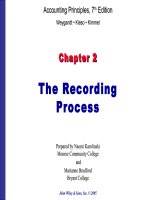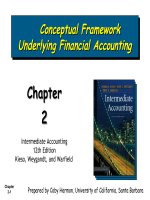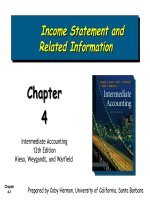Intermediate accounting 12th edition kieso warfield chapter 02
Bạn đang xem bản rút gọn của tài liệu. Xem và tải ngay bản đầy đủ của tài liệu tại đây (357.53 KB, 39 trang )
Conceptual
Conceptual Framework
Framework
Underlying
Underlying Financial
Financial Accounting
Accounting
Chapter
2
Intermediate Accounting
12th Edition
Kieso, Weygandt, and Warfield
Chapter
2-1
Prepared by Coby Harmon, University of California, Santa Barbara
Chapter
Chapter 22 Learning
Learning Objectives
Objectives
1.
Describe the usefulness of a conceptual framework.
2.
Describe the FASB’s efforts to construct a conceptual
framework.
Understand the objectives of financial reporting.
Identify the qualitative characteristics of accounting
information.
Define the basic elements of financial statements.
Describe the basic assumptions of accounting.
Explain the application of the basic principles of
accounting.
Describe the impact that constraints have on reporting
accounting information.
3.
4.
5.
6.
7.
8.
Chapter
2-2
Conceptual
Conceptual Framework
Framework
Conceptual
Conceptual
Framework
Framework
Need
Development
First
First Level:
Level:
Basic
Basic
Objectives
Second
Second Level:
Level:
Fundamental
Fundamental
Concepts
Concepts
Third
Third Level:
Level:
Recognition
Recognition and
and
Measurement
Measurement
Qualitative
characteristics
Basic elements
Basic
assumptions
Basic principles
Constraints
Chapter
2-3
Conceptual
Conceptual Framework
Framework
The Need for a Conceptual Framework
To develop a coherent set of standards and rules
To solve new and emerging practical problems
Chapter
2-4
LO 1 Describe the usefulness of a conceptual framework.
Conceptual
Conceptual Framework
Framework
Review:
A conceptual framework underlying financial
accounting is important because it can lead to
consistent standards and it prescribes the
nature, function, and limits of financial
accounting and financial statements.
True
Chapter
2-5
LO 1 Describe the usefulness of a conceptual framework.
Conceptual
Conceptual Framework
Framework
Review:
A conceptual framework underlying financial
accounting is necessary because future
accounting practice problems can be solved by
reference to the conceptual framework and a
formal standard-setting body will not be
necessary.
False
Chapter
2-6
LO 1 Describe the usefulness of a conceptual framework.
Development
Development of
of Conceptual
Conceptual Framework
Framework
The FASB has issued six Statements of Financial
Accounting Concepts (SFAC) for business enterprises.
SFAC No.1 - Objectives of Financial Reporting
SFAC No.2 - Qualitative Characteristics of Accounting Information
SFAC No.3 - Elements of Financial Statements (superceded by
SFAC No. 6)
SFAC No.4 - Nonbusiness Organizations
SFAC No.5 - Recognition and Measurement in Financial Statements
SFAC No.6 - Elements of Financial Statements (replaces SFAC No. 3)
SFAC No.7 - Using Cash Flow Information and Present Value in
Accounting Measurements
Chapter
2-7
2
LO 2 Describe the FASB’s efforts to construct a conceptual Objective
framework.
Conceptual
Conceptual Framework
Framework
The Framework is comprised of three levels:
First Level = Basic Objectives
Second Level = Qualitative Characteristics and
Basic Elements
Third Level = Recognition and Measurement
Concepts.
Chapter
2-8
LO 2 Describe the FASB’s efforts to construct a conceptual framework.
ASSUMPTIONS
PRINCIPLES
1. Economic entity
1. Historical cost
1. Cost-benefit
2. Going concern
2. Revenue recognition
2. Materiality
3. Monetary unit
3. Matching
3. Industry practice
4. Periodicity
4. Full disclosure
4. Conservatism
QUALITATIVE
CHARACTERISTICS
Relevance
Reliability
Comparability
Illustration 26 Conceptual
Framework for
Financial
Reporting
Consistency
1.
2.
3.
Chapter
2-9
CONSTRAINTS
Third
level
ELEMENTS
Assets, Liabilities, and Equity
Investments by owners
Distribution to owners
Comprehensive income
Revenues and Expenses
Gains and Losses
OBJECTIVES
Useful in investment
and credit decisions
Useful in assessing
future cash flows
About enterprise
resources, claims to
resources, and
changes in them
Second level
First level
LO 2 Describe the FASB’s
efforts to construct a
conceptual framework.
Conceptual
Conceptual Framework
Framework
Review:
What are the Statements of Financial Accounting
Concepts intended to establish?
Chapter
2-10
a.
Generally accepted accounting principles in
financial reporting by business enterprises.
b.
The meaning of “Present fairly in accordance with
generally accepted accounting principles.”
c.
The objectives and concepts for use in developing
standards of financial accounting and reporting.
d.
The hierarchy of sources of generally accepted
accounting principles.
(CPA adapted)
LO 2 Describe the FASB’s efforts to construct a conceptual framework.
First
First Level:
Level: Basic
Basic Objectives
Objectives
Financial
Financial reporting
reporting should
should provide
provide information
information that:
that:
(a)
(a) isisuseful
usefulto
topresent
presentand
andpotential
potential investors
investorsand
andcreditors
creditors
and
andother
otherusers
usersin
inmaking
makingrational
rational investment,
investment,credit,
credit,and
and
similar
similardecisions.
decisions.
(b)
(b) helps
helpspresent
presentand
andpotential
potential investors
investorsand
andcreditors
creditorsand
and
other
otherusers
usersin
inassessing
assessingthe
theamounts,
amounts,timing,
timing,and
and
uncertainty
uncertaintyof
ofprospective
prospectivecash
cashreceipts.
receipts.
(c)
(c) portrays
portraysthe
theeconomic
economicresources
resourcesof
ofan
anenterprise,
enterprise,the
the
claims
claimsto
tothose
thoseresources,
resources,and
andthe
theeffects
effectsof
of
transactions,
transactions,events,
events,and
andcircumstances
circumstancesthat
thatchange
changeits
its
resources
resourcesand
andclaims
claimsto
tothose
thoseresources.
resources.
Chapter
2-11
LO 3 Understand the objectives of financial reporting.
Conceptual
Conceptual Framework
Framework
Review:
According to the FASB conceptual framework, the
objectives of financial reporting for business
enterprises are based on?
a.
Generally accepted accounting principles
b.
Reporting on management’s stewardship.
c.
The need for conservatism.
d.
The needs of the users of the information.
(CPA adapted)
Chapter
2-12
LO 3 Understand the objectives of financial reporting.
Second
Second Level:
Level: Fundamental
Fundamental Concepts
Concepts
Question:
How does a company choose an acceptable accounting
method, the amount and types of information to
disclose, and the format in which to present it?
Answer:
By determining which alternative provides the most
useful information for decision-making purposes
(decision usefulness).
Chapter
2-13
LO 4 Identify the qualitative characteristics of accounting information.
Second
Second Level:
Level: Fundamental
Fundamental Concepts
Concepts
Qualitative Characteristics
“The FASB identified the Qualitative Characteristics
of accounting information that distinguish better
(more useful) information from inferior (less useful)
information for decision-making purposes.”
Chapter
2-14
LO 4 Identify the qualitative characteristics of accounting information.
Second
Second Level:
Level: Qualitative
Qualitative Characteristics
Characteristics
Illustration 2-2
Hierarchy of
Accounting
Qualities
Chapter
2-15
LO 4 Identify the qualitative characteristics of accounting information.
Second
Second Level:
Level: Fundamental
Fundamental Concepts
Concepts
Understandability
A company may present highly relevant and reliable
information, however it was useless to those who do
not understand it.
Chapter
2-16
LO 4 Identify the qualitative characteristics of accounting information.
ASSUMPTIONS
PRINCIPLES
CONSTRAINTS
1. Economic entity
1. Historical cost
1. Cost-benefit
2. Going concern
2. Revenue recognition
2. Materiality
4. Full disclosure
4. Conservatism
3. Matching
3. Industry practice
Relevance
and
Relevance
and Reliability
Reliability
3. Monetary unit
4. Periodicity
QUALITATIVE
CHARACTERISTICS
Relevance
Reliability
Comparability
Illustration 26 Conceptual
Framework for
Financial
Reporting
Consistency
1.
2.
3.
Chapter
2-17
Third
level
ELEMENTS
Assets, Liabilities, and Equity
Investments by owners
Distribution to owners
Comprehensive income
Revenues and Expenses
Gains and Losses
OBJECTIVES
Useful in investment
and credit decisions
Useful in assessing
future cash flows
About enterprise
resources, claims to
resources, and
changes in them
Second level
First level
LO 4 Identify the qualitative
characteristics of
accounting information.
Second
Second Level:
Level: Qualitative
Qualitative Characteristics
Characteristics
Primary Qualities:
Relevance – making a difference in a decision.
Predictive value
Feedback value
Timeliness
Reliability
Verifiable
Representational faithfulness
Neutral - free of error and bias
Chapter
2-18
LO 4 Identify the qualitative characteristics of accounting information.
Second
Second Level:
Level: Qualitative
Qualitative Characteristics
Characteristics
Review:
Relevance and reliability are the two primary
qualities that make accounting information useful
for decision making.
True
To be reliable, accounting information must be
capable of making a difference in a decision.
False
Chapter
2-19
LO 4 Identify the qualitative characteristics of accounting information.
ASSUMPTIONS
PRINCIPLES
CONSTRAINTS
1. Economic entity
1. Historical cost
1. Cost-benefit
2. Going concern
2. Revenue recognition
2. Materiality
4. Full disclosure
4. Conservatism
3. Matching
3. Industry practice
Comparability
and
Comparability
and Consistency
Consistency
3. Monetary unit
4. Periodicity
QUALITATIVE
CHARACTERISTICS
Relevance
Reliability
Comparability
Illustration 26 Conceptual
Framework for
Financial
Reporting
Consistency
1.
2.
3.
Chapter
2-20
Third
level
ELEMENTS
Assets, Liabilities, and Equity
Investments by owners
Distribution to owners
Comprehensive income
Revenues and Expenses
Gains and Losses
OBJECTIVES
Useful in investment
and credit decisions
Useful in assessing
future cash flows
About enterprise
resources, claims to
resources, and
changes in them
Second level
First level
LO 4 Identify the qualitative
characteristics of
accounting information.
Second
Second Level:
Level: Qualitative
Qualitative Characteristics
Characteristics
Secondary Qualities:
Comparability – Information that is measured and
reported in a similar manner for different companies
is considered comparable.
Consistency - When a company applies the same
accounting treatment to similar events from period
to period.
Chapter
2-21
LO 4 Identify the qualitative characteristics of accounting information.
Second
Second Level:
Level: Qualitative
Qualitative Characteristics
Characteristics
Review:
Adherence to the concept of consistency
requires that the same accounting principles be
applied to similar transactions for a minimum of
five years before any change in principle is
adopted.
False
Chapter
2-22
LO 4 Identify the qualitative characteristics of accounting information.
ASSUMPTIONS
PRINCIPLES
1. Economic entity
1. Historical cost
1. Cost-benefit
2. Going concern
2. Revenue recognition
2. Materiality
3. Monetary unit
3. Matching
3. Industry practice
4. Periodicity
4. Full disclosure
4. Conservatism
Elements
Elements
QUALITATIVE
CHARACTERISTICS
Relevance
Reliability
Comparability
Illustration 26 Conceptual
Framework for
Financial
Reporting
Consistency
1.
2.
3.
Chapter
2-23
CONSTRAINTS
Third
level
ELEMENTS
Assets, Liabilities, and Equity
Investments by owners
Distribution to owners
Comprehensive income
Revenues and Expenses
Gains and Losses
OBJECTIVES
Useful in investment
and credit decisions
Useful in assessing
future cash flows
About enterprise
resources, claims to
resources, and
changes in them
Second level
First level
LO 5 Define the basic
elements of financial
statements.
Second
Second Level:
Level: Elements
Elements
Concepts Statement No. 6 defines ten interrelated
elements that relate to measuring the performance and
financial status of a business enterprise.
“Moment in Time”
Assets
Liabilities
Equity
Chapter
2-24
“Period of Time”
Investment by owners
Distribution to owners
Comprehensive income
Revenue
Expenses
Gains
Losses
LO 5 Define the basic elements of financial statements.
Second
Second Level:
Level: Elements
Elements
Exercise 2-3 Identify the element or elements associated
with items below.
Elements
(a) Arises from peripheral or
incidental transactions.
Assets
(b) Liabilities
(b) Obligation to transfer
resources arising from a
past transaction.
(c) Increases ownership
interest.
(d) Declares and pays cash
dividends to owners.
(e) Increases in net assets in a
period from nonowner
Chapter
sources.
2-25
Equity
(e)
(c) Investment by owners
(d) Distribution to owners
(c) Comprehensive income
Revenue
Expenses
(a)
Gains
(a)
Losses
LO 5 Define the basic elements of financial statements.









